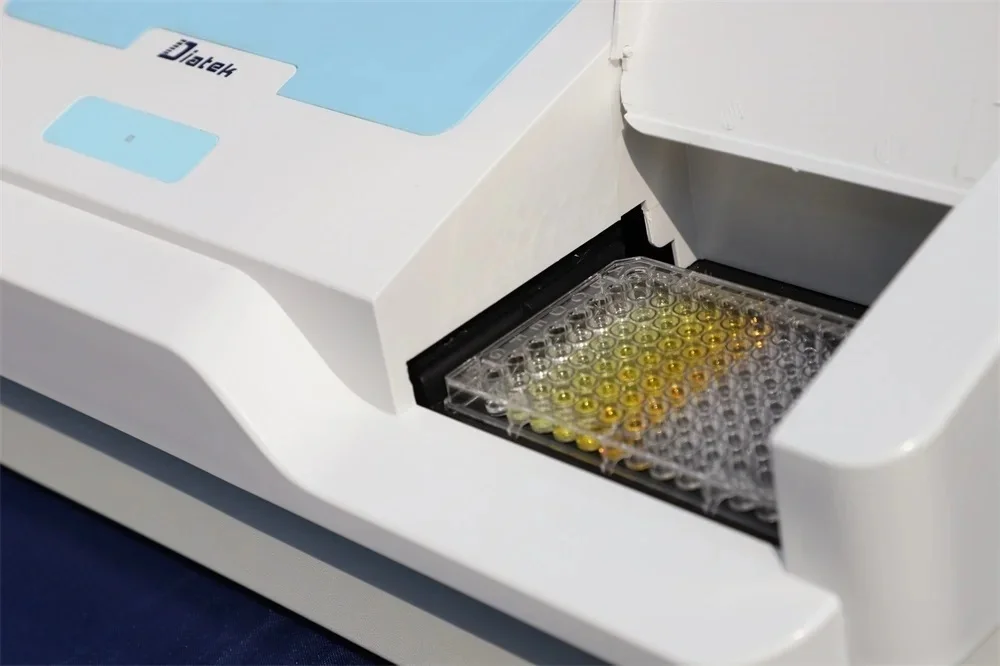Microplate readers are essential tools in laboratories, widely used for various applications, including biochemical assays, drug discovery, and clinical diagnostics. Their ability to perform high-throughput analysis makes them invaluable in research and clinical settings. However, with their advanced technology and complex operations, safety considerations are paramount. This article will explore key safety practices when using microplate readers, emphasizing the importance of proper handling and maintenance, with insights from DIATEK, a leader in laboratory equipment solutions.

1. Understanding the Equipment
Before operating a microplate reader, it’s crucial to understand its components and functions. A typical microplate reader includes:
- Light Source: Provides the necessary illumination for detecting signals.
- Optical System: Focuses light onto the microplate and collects emitted signals.
- Detector: Converts light signals into measurable data.
- Control Software: Manages data acquisition and analysis.
Familiarity with these components can help users identify potential hazards and operate the equipment safely.
2. Personal Protective Equipment (PPE)
When working with microplate readers, wearing appropriate personal protective equipment is essential. This includes:
- Lab Coats: Protects against spills and contamination.
- Safety Goggles: Shields eyes from chemical splashes or harmful light.
- Gloves: Prevents skin contact with potentially hazardous materials.
Always ensure that PPE is suitable for the specific chemicals or biological materials being used in conjunction with the microplate reader.
3. Chemical Safety
Many assays performed using microplate readers involve chemicals that can be hazardous. Here are some safety tips:
- Material Safety Data Sheets (MSDS): Always consult the MSDS for chemicals used in your experiments to understand their hazards and necessary precautions.
- Proper Labeling: Ensure all reagents are clearly labeled with contents, concentrations, and hazard warnings.
- Storage: Store chemicals according to their compatibility and hazard classifications to prevent reactions or spills.
4. Handling Biological Samples
Microplate readers are often used for assays involving biological samples, which may pose biohazard risks. To ensure safety:
- Containment: Use biosafety cabinets when handling infectious or potentially harmful biological materials.
- Disposal: Follow proper biohazard disposal protocols for any waste generated during experiments.
- Decontamination: Clean surfaces and equipment thoroughly after handling biological samples to prevent cross-contamination.
5. Electrical Safety
Microplate readers are electrical devices that require careful handling to avoid electrical hazards:
- Inspect Cords and Plugs: Regularly check power cords and plugs for damage before use. Do not operate the device if there are any visible defects.
- Grounding: Ensure that the equipment is properly grounded to prevent electrical shocks.
- Water Exposure: Keep liquids away from electrical components to avoid short circuits or electrocution.
6. Maintenance and Calibration
Regular maintenance and calibration of microplate readers are essential for accurate results and safe operation:
- Routine Checks: Schedule regular inspections of the optical system, light source, and detector to ensure they are functioning correctly.
- Calibration: Follow manufacturer guidelines for calibrating the device to maintain accuracy in measurements.
- Cleaning Protocols: Use appropriate cleaning solutions recommended by the manufacturer to clean optical surfaces without causing damage.
7. Training and Competence
Proper training is crucial for anyone operating a microplate reader:
- User Training: Ensure all users receive adequate training on how to operate the equipment safely and effectively.
- Standard Operating Procedures (SOPs): Develop SOPs that outline safe operating practices for using the microplate reader, including emergency procedures.
8. Emergency Procedures
Despite best efforts at safety, accidents can happen. Having emergency procedures in place is vital:
- Emergency Contacts: Keep a list of emergency contacts readily available in case of accidents or exposure incidents.
- Spill Kits: Have spill kits on hand for quick response to chemical spills or leaks around the microplate reader.
- First Aid Kits: Ensure first aid kits are stocked and accessible in case of injuries related to chemical exposure or electrical accidents.
Conclusion
Microplate readers are powerful tools that enhance research capabilities across various fields; however, their safe operation requires attention to detail and adherence to safety protocols. By understanding the equipment, wearing appropriate PPE, handling chemicals carefully, ensuring electrical safety, performing regular maintenance, providing adequate training, and having emergency procedures in place, laboratories can create a safe working environment.
At DIATEK, we prioritize safety alongside performance in our laboratory equipment solutions. Our commitment extends beyond providing high-quality microplate readers; we also strive to educate our customers on best practices for safe operation. If you have any questions about our products or need further information on safe laboratory practices, feel free to reach out! Together, we can ensure a safer laboratory experience while achieving excellent research outcomes.







Comments (0)